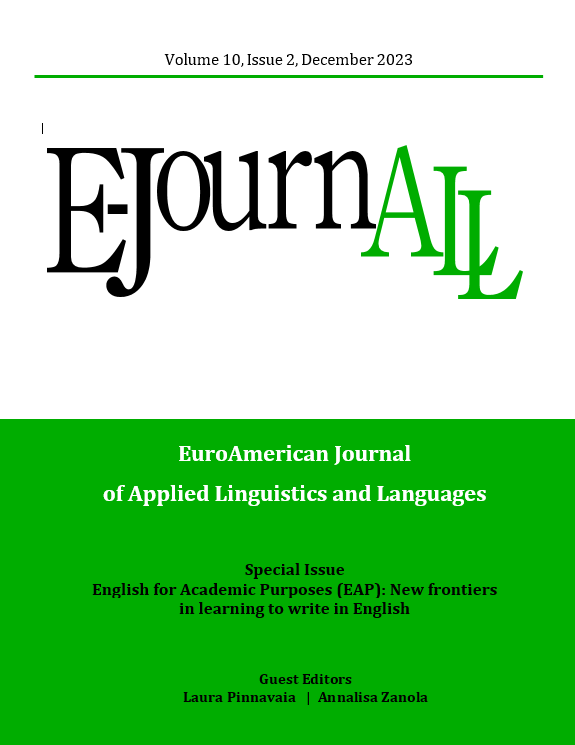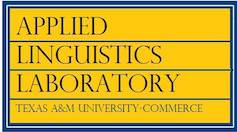Exploring interactive metadiscourse as a practical approach to enhancing academic writing skills of newly admitted undergraduates students in Nigeria
DOI:
https://doi.org/10.21283/2376905X.1.10.2.2756Keywords:
academic writing skills, interactive metadiscourse, ESL undergraduates in Nigeria, discursive strategiesAbstract
Academic writing is a crucial aspect of undergraduate education, particularly for students in English as Second Language (ESL) situations. This study investigates the use of interactive resources as discursive strategies in enhancing the academic writing skills of ESL undergraduate students in Nigeria. The research employs both qualitative and quantitative designs. The qualitative component analyses the types and usages of discursive strategies employed in the selected expository writing, while the quantitative component involved calculating the frequency of occurrence of these strategies. A sample of 100 expository essays were used. The results reveal transitional markers, frame markers, and code glosses were the most frequently used interactive markers in the academic writing produced by ESL undergraduate students, while evidential and endophoric markers were used less frequently. These findings highlight the importance of incorporating interactive resources and discursive strategies in the teaching of academic writing skills to undergraduate students in an ESL context.
References
Adegbite, Efurosibina (2012). Corporate governance regulation in Nigeria, Corporate Governance, 12(2), 257–276. https://doi.org/10.1108/14720701211214124
Akinseye, Tolulope A. (2021). Metadiscursive markers in second language theses abstract, British Journal of Applied Linguistics, 1(1), 14–28. https://doi.org/10.32996/bjes.2021.4.1.3
Bridgeman, Brent, & Carlson, Sybil (1983). Survey of academic writing task required of graduate and undergraduate foreign students. TOEFL Research Report No. 15. Educational Testing Service. http://dx.doi.org/10.1002/j.2330-8516.1983.tb00018.x
Carkin, Susan (2005). English for Academic purposes. In Eli Hinkel (Ed.), Handbook of Research in Second Language Teaching and Learning (pp. 85-98). Lawrence Erlbaum Associates. https://doi.org/10.4324/9781410612700
Castro, Carolyn (2004). Cohesion and social construction of meaning in the essays of Filipino college students writing in L2 English, Asia Pacific Education Review, 5, 215–225. https://doi.org/10.1007/BF03024959
Chiang, Steve (2003). The importance of cohesive conditions to perceptions of writing quality at the early stages of foreign language learning. System, 31, 471–484. http://dx.doi.org/10.1016/j.system.2003.02.002
Crismore, Avon, Markkanen, Raija, & Steffensen, Margaret (1993). Metadiscourse in persuasive writing: A study of texts written by American and Finnish university students. Written Communication, 10, 39–71. https://doi.org/10.1177/0741088393010001002
Coleman, Hywel (1988). Analyzing needs in large organizations. English for Specific Purposes, 7(3), 155–169. https://doi.org/10.1016/0889-4906(88)90013-0
Feng, Cao, & Hu, Guangwei (2014). Interactive metadiscourse in research articles: A comparative study of paradigmatic and disciplinary influences. Journal of Pragmatics, 66, 15-31. https://doi.org/10.1016/j.pragma.2014.02.007
Flowerdew, John, & Peacock, Matthew (2001). Issues in EAP: A preliminary perspective. In John. Flowerdew & Matthew. Peacock, (Eds.), Research perspectives on English for Academic Purposes (pp. 8–24). Cambridge University Press. https://doi.org/10.1017/CBO9781139524766
Franzosi, Roberto, & Vicari, Stephania (2018). What's in a Text?: Answers from Frame Analysis and Rhetoric for Measuring Meaning Systems and Argumentative Structures, Rhetorica: A Journal of the History of Rhetoric, 36(4), 393–429. https://doi.org/10.1525/rh.2018.36.4.393
Gholami, Javad, Nejad, Sara Rafsanjani, & Pour, Jahanbakhsh Looragi (2014). Metadiscourse Markers Misuses: a Study of EFL Learners’ Argumentative Essays, Procedia - Social and Behavioral Sciences, 98, 580–589. http://dx.doi.org/10.1016/j.sbspro.2014.03.454
Halliday, Michael, & Hasan, Ruqaiya (1989). Language, Context and Text: Aspects of Language in a Social-Semiotic Perspective. Oxford University Press.
Harris, Zellig (1959). Computable Syntactic Analysis: The 1959 Computer sentence-analyser. Transformation and Discourse Analysis Papers 15.
Haruna, Hamisu, Ibrahim, Bello, Haruna, Musa, Ibrahim, Bashir, & Yunus, Kamariah (2018). Metadiscourse in students’ academic writing: case study of Umaru Musa Yar’adua University and Al-Qalam University Katsina. International Journal of English Linguistics, 8(7) 83–92. https://doi.org/10.5539/ijel.v8n7p83
Harsyaf, Nurmaini, & Izmi, Zakhwan (2009). Teaching writing. Ministry of National Educations.
Hutchinson, Tom, & Waters, Alan (1987). English for Specific Purposes. A learning centered approach. Cambridge University Press. http://dx.doi.org/10.1017/CBO9780511733031
Hyland, Ken, & Hamp-Lyons, Liz (2002). EAP: Issues and directions. Journal of English for Academic Purposes, 1, 1–12. http://dx.doi.org/10.1016/S1475-1585(02)00002-4
Hyland, Ken (2004). ‘Engagement and disciplinarity: the other side of evaluation’ in Gabriella Del Lungo Camiciotti & Elena Tognini Bonelli (Eds.), Academic discourse: new insights into evaluation (pp. 13–30). Peter Lang.
Hyland, Ken (2005). Metadiscourse: Exploring interaction in writing. Continuum. http://dx.doi.org/10.1017/S0047404508080111
Hyland, Ken, & Jiang, Kevin (2018). Text-organizing metadiscourse: tracking changes in rhetorical persuasion, Journal of Historical Pragmatics, 21(1), 137–164. http://dx.doi.org/10.1075/jhp.00039.hyl
Johns, Ann (1981). Necessary English: A faculty survey. TESOL Quarterly 15, 51–57. https://doi.org/10.2307/3586373
Jones, Jeremy (2011). Using metadiscourse to improve coherence in academic writing, Language Education in Asia, 2(1), 1-14. http://dx.doi.org/10.5746/LEiA/11/V2/I1/A01/JFJones
Jordan, Robert R. (2002). The growth of EAP in Britain, Journal of English for Academic Purposes, 1(1), 69–78. http://dx.doi.org/10.1016/S1475-1585(02)00004-8
Kimbrough, William (2013). ‘What is College for?’ Interview with The chronicle Journal, USA.
Liu, Meihua & Braine, George (2005). Cohesive features in argumentative writing produced by Chinese undergraduates, System, 33, 623–636. http://dx.doi.org/10.1016/j.system.2005.02.002
Mawardi Amin (2011). An Analysis of the Cohesion and Coherence of the Students’ Narrative Writings in the English Language Education. Department of Nahdlatul Wathan Mataram University. (Unpublished master's thesis). Gunung Rinjani University.
Mardani, Tooba (2017). Metadiscourse markers: A contrastive study of translated and non-translated persuasive texts, Journal of Language and Translation, 7(2), 73–79. https://dorl.net/dor/20.1001.1.20088590.2017.7.2.7.3
Mo, Huanran (2005). A brief review of English for academic purposes (EAP), US-China Foreign Language, 3(7), 62–67.
Munby, John (1978). Communicative syllabus design. Cambridge University Press. https://doi.org/10.2307/3586758
Pérez-Llantada, Carmen (2010). The discourse functions of metadiscourse in published academic writing: Issues of culture and language, Nordic Journal of English Studies, 9(2), 41-68. https://doi.org/10.35360/njes.217
Qin, Wenjuan, & Uccelli, Paola (2019). Metadiscourse: Variation across communicative contexts, Journal of Pragmatics, 139, 22-39. https://doi.org/10.1016/j.pragma.2018.10.004
Rustipa, Katharina (2014). The Effectiveness of Direct and Indirect Written Corrective Feedback in Improving EFL Learners’ Hortatory Exposition Writing, The 61st TEFLIN International Conference Proceedings, 7-9 October, Solo, Indonesia. https://eprints.unisbank.ac.id/id/eprint/3106
Schiffrin, Deborah (1980). Meta-talk: Organizational and evaluative brackets in discourse, Sociological Inquiry, 50, 199–236. http://dx.doi.org/10.1111/j.1475-682X.1980.tb00021.x
Shafique, Haroon, Shahbaz, Muhammad, & Hafeez, M. Rasheed (2019). Metadiscourse in research writing: A study of native English and Pakistani Pakistani scholars. Journal of English for Academic Purposes, 39, 74–86. https://doi.org/10.5539/ijel.v9n4p376
Sinclair, John (1991). Corpus, concordance, collocation. Oxford University Press. https://doi.org/10.1177/003368829302400207
Taghizadeh, Mahboubeh & Tajabadi, Fahimeh (2013). Metadiscourse in essay writing: An EFL case. International Research Journal of Applied and Basic Sciences, 4(7), 1658–1662.
Tan, Helen, & Eng, Wong Bee (2014). Metadiscourse use in the persuasive writing of Malaysian undergraduate students, English Language Teaching, 7(7), 26–39. http://dx.doi.org/10.5539/elt.v7n7p26
Vahid Dastjerdi, Hossein & Shirzad, Maryam (2010). The impact of explicit instruction of metadiscourse markers on EFL learners' writing performance, The Journal of Teaching Language Skills, 29(2), 155–174. https://doi.org/10.22099/jtls.2012.412
Van de Kopple, William J. (1985). Some exploratory discourse on metadiscourse, College Composition and Communication, 36, 82–93. https://doi.org/10.2307/357609
Wei, Zhu, & Flaitz, Jeffra (2005). Using focus group methodology to understand international students’ academic language needs: A comparison of perspectives. TESL-EJ, 8(4). Retrieved 14 March 2009, from http://writing.berkeley.edu/TESL-EJ/ej32/a3.html
Williams, Joseph (1981). Style: Ten lessons in clarity and grace. Scott, Foresman. https://www.jstor.org/stable/20865521
Yang, Wenxing, & Sun, Ying (2012). The use of cohesive devices in argumentative writing by Chinese EFL learners at different proficiency level, Linguistics and Education, 23, 31–48. http://dx.doi.org/10.1016/j.linged.2011.09.004
Zughoul, Muhammad and Hussein, Riad F. (1985). English for higher education in the Arab world: A case study of needs analysis at Yarmouk University, The ESP Journal, 4(2), 132–152. http://dx.doi.org/10.1016/0272-2380(85)90016-2
Downloads
Published
How to Cite
Issue
Section
Categories
License
Copyright (c) 2023 TOLULOPE AKINSEYE

This work is licensed under a Creative Commons Attribution 4.0 International License.


